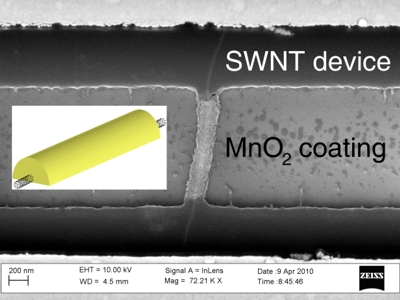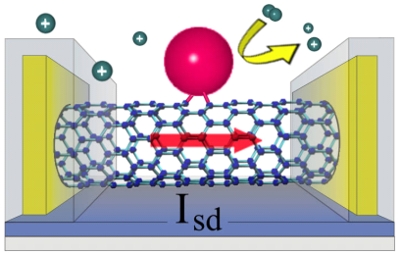 |
|
|
|
 |
|
|
 |

|
 |
 |
 |
 |
 |
 |
 |
Nanoscale Electrochemistry and Li-ion Batteries |
The feasibility of longer lasting and better performing portable electronics and electric vehicles
relies on the improvement of energy storage devices that can store more
charge and deliver higher power. Our research investigates the basic physics and
electrochemistry of heterogeneous nanostructured pseudocapacitors, a promising hybrid between
traditional batteries and capacitors. The properties of these heterogeneous composites usually depend on
buried interfaces that are very difficult to study.
Using individual carbon nanotubes, we build model systems that can be easily interrogated
by microscopy, electronic transport, and electrochemical measurements. Nanotubes provide
high conductivity and electrochemical stability, while a metal oxide like MnO2 provides
a good charge storage material. By investigating the properties of a single particle
interacting with a single SWNT, we can understand the interfacial effects that lead to tradeoffs
between capacity, stability, charge/discharge rates, and efficiency. We also consider the effects
of defects and other surface chemistry towards optimizing different properties.
Our research also investigates similar model systems combining SWNTs with other types of active particles,
including catalytic particles, optical and SERS-active particles, and redox-active molecules. In each
case, we work to understand the transfer of chemical energy into electrical energy, and vice versa.
Using SWNT transistors and different types of attachments, we can probes a wide range of
physical phenomena with nanoscale precision.
|
 |
Publications |
Electrochemical Charge-Transfer Resistance in Carbon Nanotube Composites
B.L. Corso, I. Perez, T. Sheps, P.C. Sims, O.T. Gül & P. G. Collins,
Nano Lett. 14, 1329 (2014).
Conformal MnO2 Electrodeposition Onto Defect-Free Graphitic Carbons
I. Perez, B.L. Corso, V.R. Khalap & P.G. Collins,
Electrochemistry Communications 13, 590-2 (2011).
Hydrogen Sensing and Sensitivity of Palladium-Decorated Single-Walled Carbon Nanotubes with Defects
V.R. Khalap, T. Sheps, A.A. Kane & P.G. Collins,
Nano Lett. 10, 896-901 (2010).
Identifying and Counting Point Defects in Carbon Nanotubes
Y. Fan, B.R. Goldsmith, P.G. Collins,
Nature Materials 4, 906 (2005)
|
 |
Acknowledgements |
| This research is supported by the U.S. Department of Energy
|

 |
|
 |
 |
through NEES,
the Science of Precision Multifunctional Nanostructures
for Electrical Energy Storage, an Energy Frontier Research Center funded
by the U.S. Department of Energy, Office of Science,
Office of Basic Energy Sciences, Award #DESC0001160.
|
|
|
 |
|
|
|


A SWNT transistor coated with a nanoscale film of the cathode material MnO2.


Electrochemical cycling of nanoscale model systems, comparing
two types of nanotubes to Pt and graphite current collectors.




SWNT transistors provide ultra-sensitive readout of chemical
activity from single catalyst particles.
|
 |



